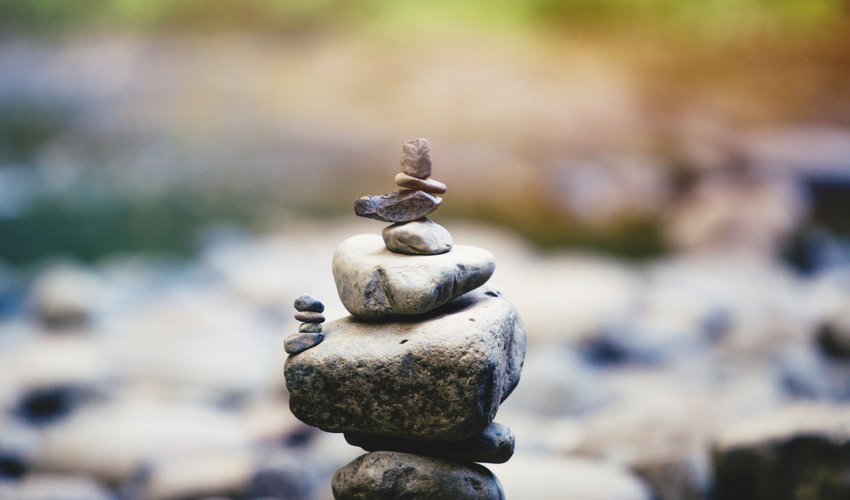Breathing Exercises for Stress Management
Whether your stress stems from an upcoming client meeting, a lack of sleep, an ongoing health issue or something completely different, the research is clear: breathing can help. In this article, learn about a variety of research-supported breathing exercises to help ease your stress and find the ones that work best for you!

How Does Breathing Help Ease Stress?
Every human being comes equipped with something scientists call the "fight or flight response." What is so interesting about the human fight or flight response, also called the "acute stress response," is that it often gets triggered unnecessarily by incidents that pose no immediate survival threat.
The modern human being is largely removed from the food chain, that eat-or-get-eaten existence that every other living being confronts each moment of every single day. The things that trigger your stress response may not be pleasant, but most of them won't kill you. However, your stress response doesn't know this. It can't distinguish between the threat posed by your upcoming quarterly performance review and the threat posed by the hungry tiger lurking behind a nearby shrub.
Since your "fight or flight" ancient limbic brain structure will never learn the difference, you have to learn to actively help your stress response calm down. Luckily your body also has an inbuilt stress-calming mechanism: your breath.
Deep breathing tells your body that the survival threat has passed - it is safe to come back out, resume living your life, BREATHE.
Fire-Breathing
Fire breathing is not quite so exotic as it may sound, but boy does it work! With fire-breathing, you start out by breathing through your mouth and then transition to breathing through your nose.
Here is what to do:
- Start by panting - yes, just like a dog would do when he's too hot. Pant, pant, pant until you start to feel your diaphragm (that part just above your tummy) get a little tired.
- Then switch and close your mouth and start breathing deeply through your nose. Keep panting, but do it with a closed mouth this time.
- Stop and notice how you feel. You probably feel a bit wired, a bit tired and a lot less stressed!
Alternate Nostril Breathing
Alternate nostril breathing, like many of the breathing strategies that work best, is not a new invention. In fact, we have ancient yogis to thank for this modern day miracle worker!
Alternate nostril breathing, as its name suggests, encourages you to breathe in a deliberate way through your nostrils.
To do this, you will need a little help from your thumb and ring finger on one hand (it doesn't matter which hand, or you can alternate hands).
Here is what to do:
- Take your right thumb and use it to block your right nostril.
- Exhale the breath in your body through your left nostril.
- Now inhale a deep breath through your left nostril.
- Next, take your right ring finger and block the left nostril.
- Now exhale the breath through your right nostril.
- Reverse and repeat.
Do this a few times and then stop and notice how you feel. This is a great breathing exercise to redirect your mind as well, since it has to drop the stressful thoughts it has been favouring to help direct the nostril breathing instead!
Belly Breathing (Diaphragmatic Breathing)
Diaphragmatic breathing is another ancient yogic favourite that helps a lot of modern people out of stressful jams every day.
What you need to know for this one is the exact location of your diaphragm. This is the big, powerful muscle wall that supports your breathing. It is situated right beneath the bottom of your lungs, so it is basically between your waistline and the bottom of your rib cage.
You can place our hand right above your belly button and take a big breath in, then breathe out, to feel your diaphragm at work.
You can do belly breathing either while lying down on the floor or by sitting down on the floor or on a chair. With a little practice, you can even do it while waiting in line for a coffee or while sitting in a chair at a conference with no one being the wiser!
This is how to do belly breathing:
- Get into a place where you have the best opportunity to actually feel your tummy move in and out as you breathe (this is particularly important if this is your very first time learning diaphragmatic breathing).
- Take one hand (doesn't matter which one) and place it on your diaphragm just above your belly button. Then take the other hand and place it on your chest.
- Begin to breathe in with a closed mouth, doing your best to keep your chest level and stationary. Focus on feeling the breath fill up your belly area. Try to fill your belly up with air completely as your hand gets pushed out further and further.
- Pause for just a moment to feel your belly full of air.
- Now, begin to exhale through your mouth, using your hand to gently guide your stomach to deflate. You can exhale silently or make a sound (although you might save the sound for times when you are doing this exercise alone!).
- Repeat these steps several times, then sit quietly and notice how you feel. You probably will notice right away how your heart rate has evened out and slowed down.
Ujjayi Breathing (Victorious Breathing)
Ujjayi (pronounced "ooh-jah-eee") breathing also comes from the ancient yogic tradition. This breathing strategy marries breath and sound to help you feel the Ujjayi, or victorious, state for yourself, which is a wonderful antidote to stress!
Sometimes also called the "hissing breath" because it can sound like a hissing cobra, Ujjayi breathing teaches you to control your breath and thus, to control your stress.
Here is how to do Victorious breathing:
- Sit down comfortably on the floor or in a chair and get settled. For this breathing technique you want your back to be straight and your body to feel supported.
- Begin to inhale through your mouth steadily. When you feel like your lungs are full of air, pause.
- As you begin the exhalation, imagine you are whispering your breath out, to the point where you feel your vocal cords contract slightly as if you were to actually start whispering! As the breath exhales out past your vocal cords, let a hissing sound emerge.
- Pause at the end of your exhalation. Then begin to inhale again, this time imagining you are whispering in your inhalation as well. Feel that slight constriction of your vocal cords and let your breath come in with a hissing sound.
- Repeat. If it helps you can also think of the sound like it is the white noise sound the ocean waves make as they flow in and out.
- Stop and notice how you feel. Do you feel more in control, more steady, ready to be victorious over your stress? Many people do after doing Ujjayi breathing!
Dr. Weil's 4-7-8 Breathing (Relaxing Breath)
Dr. Andrew Weil is an internationally known holistic health expert. One of his favourite breathing exercises, which he calls "Relaxing Breath," is the 4-7-8 breathing exercise.
This is what you need to do:
- First, sit down in a comfortable position and exhale your breath fully.
- Next, close your mouth and begin to quietly inhale to a count of "1, 2, 3, 4."
- Then hold your breath to a count of "1, 2, 3, 4, 5, 6, 7."
- Then audibly exhale your held breath to a count of "1, 2, 3, 4, 5, 6, 7, 8."
- Repeat the cycle up to four times completely (but no more than four times in a row).
Continue to sit quietly and notice how you feel. You can practice with speeding up or slowing down the count to see what works best for you. You will probably notice that your mind as well as your body feels quieter and more calm after doing 4-7-8 breathing.
Equal Breathing
Equal breathing is a wonderful breathing technique that you can do any time, anywhere and in any position. You can choose the length of your inhale/exhale cycle and try different lengths to see what you prefer.
This is how to do equal breathing:
- Stand, sit down or lie down - whatever you prefer or whatever is convenient for you.
- Choose a count (4, 5, or 6 count is good to start with).
- Close your mouth and inhale through your nose to your chosen count ("1, 2, 3, 4").
- Exhale through your nose to your chosen count ("1, 2, 3, 4").
Do this until you begin to feel a sense of calm easing over you. You want to choose a count that encourages you to breathe in deep without making you feel like you are struggling, so this may be something you want to experiment with to find just the right length for the inbreath/outbreath cycle.
Affirming Breathing
If you are someone who enjoys repeating affirmations or intentions, this may become your favourite calming breath exercise! With affirming breathing, your goal is to give your mind a soothing thought to ponder while you give your body lots of soothing oxygen to calm itself with.
Here is what to do:
- First, select a phrase that evokes calm, trust, ease or peace. You may have a phrase you love or you can listen within and see what comes up (it might just be something as simple as "my stress melts away").
- Begin breathing in and out, word by word. So, using the phrase "my stress melts away" as an example, you will start by breathing in the word "my."
- Next, breathe in and out using the word "stress."
- Then breathe in and out using the word "melts."
- Finally, breathe in and out using the word "away."
The goal is to use the breath to help your mind really hear and focus on each word, rather than just repeating the phrase on the side while returning to its long list of things to worry about! As you get better at this breathing exercise, you will likely begin to notice your mind becoming quieter along with your body.
Muscle Relaxation Breath
This self-guided relaxation technique uses your breath, your mind and your body to help turn off your stress response and allow ease and calm to seep back into your awareness on a physical, mental and emotional level.
You may want to record yourself giving the instructions and listen to the recording, or you can give yourself instructions silently in your mind as you breathe. You can do this sitting or standing, but it is most effective when you are lying down quietly.
This is what to do:
- Start at the crown of your head. Feel the tension in your head. Say to yourself, "Relax your head." Pause for a moment to relax the tense muscles deliberately.
- Move to your neck. Feel the tension and say to yourself, "Relax your neck." Pause to allow those tense muscles to relax.
- Now move to your shoulders. Feel the tension and say to yourself, "Relax your shoulders." Pause to allow the shoulder muscles to relax.
- Continue all the way down through your body until even your toes are feeling relaxed.
You can do this breathing exercise with as little or as much detail as you wish depending on your available time.
Wellness Workshops in Bangkok
Join us for lifestyle wellness workshops in Bangkok led by Leila El Krekshi, a certified yoga instructor who qualified at the world’s oldest organised yoga institution in India, and has practised meditation, yoga, dance and capoeira for most of her life. She also has extensive experience leading retreats around the world that integrate multiple therapies, including yoga, creative movement and mindfulness at akyra.
Related Articles:
- Yoga Breathing Exercises for Relaxation
- Reducing Urban Stress In Bangkok
- Sustainable Travel Tips
- Guide to Sustainable Travel
- Sustainable Hotels in Thailand
- Single Use Plastic Free Hotels
Others Blog
Latest Post
The Karen Hill Tribes of Chiang Mai
22/04/24Extend Your Stay in Chiang Mai
01/04/24



